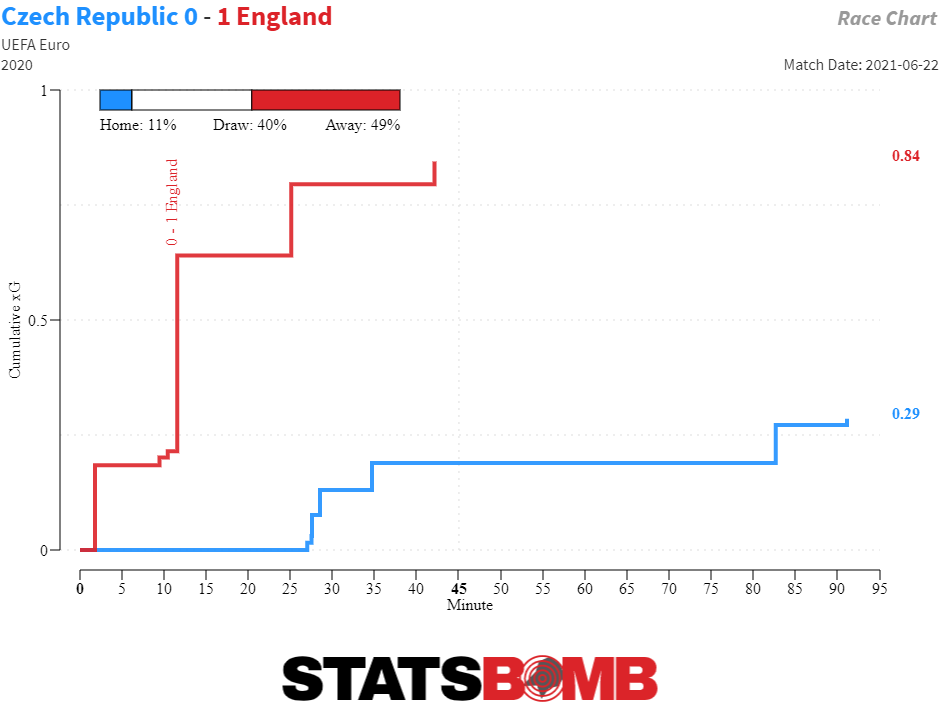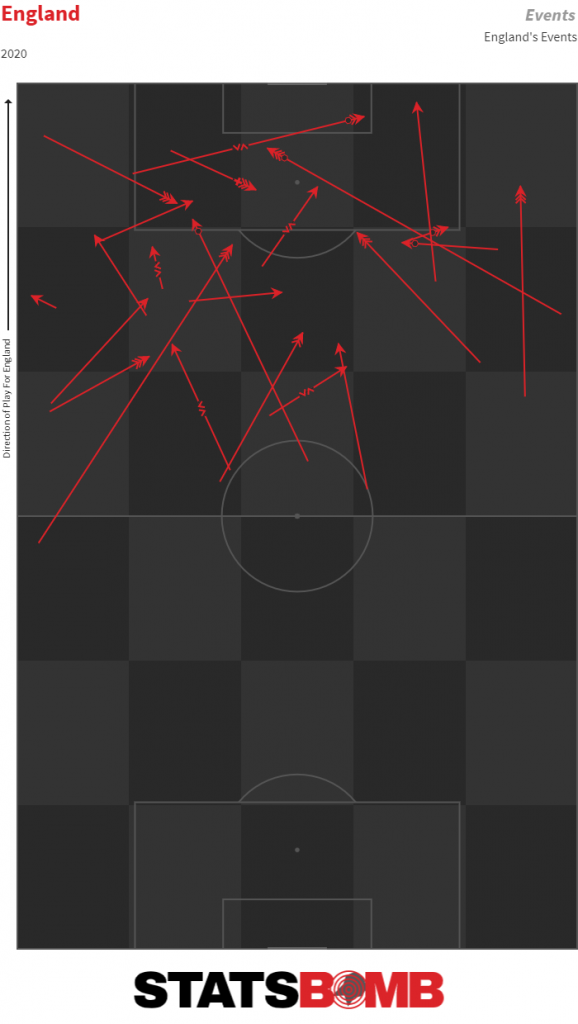Data has become an integral part of team and opposition analysis in the modern game: a repeatable and automated part of the process that can quickly identify longer-term trends and save valuable time for the busy analyst. Teams and federations use StatsBomb IQ to support their team and opposition analysis, exploiting edges found in the platform to secure victory over their opponents every matchday. Looking ahead to England vs Germany in the Euro 2020 round of 16, let’s demonstrate how this can be done.
GERMANY
Germany come into this game having survived the Group of Death, qualifying after a late Leon Goretzka equaliser in the deciding group game versus Hungary saved them from an early exit. As a collective, there have been question marks over Germany's performances in the group stage, but matches against strong nations in France and Portugal should provide us some clues as to how they might setup against England. The first thing to note is that Germany conceded the first goal in all three of their group stage games - in fact, each of those goals was scored within the opening 20 minutes of the game. As a result, their data is skewed slightly favourably with Die Mannschaft playing a more attacking mentality to chase the games than they're likely to operate with from the start against England.

Sure enough, Germany controlled the shot counts in all three games (10-4, 13-7, and 18-9 respectively) as well as the territory, completing 272 final third entries to their opponents 80.

BUILD UP
Germany look to play short from the goalkeeper, with an average goalkeeper pass length of 29.9m the 4th-shortest of the teams qualified from the group stage.

Neuer has distributed evenly between the two sides of defence, playing 19 defensive third passes to Antonio Rudiger and 17 to Matthias Ginter, with the two wide centre backs charged with carrying the ball up the pitch before distributing to Mats Hummels at the centre of the back three, or Toni Kroos. Should the centre backs be unavailable for a short, ground pass, Neuer has found joy playing Low (not to be confused with Löw) or High passes to Robin Gosens on the left flank, but Neuer has so far struggled making these same passes to the right flank.

Though influenced by the game state, particularly against Hungary where they were attacking a low block for long periods of the second half, their proclivity for moving the ball side-to-side in the build up shows up in their Directness rating – the total distance from goal at the start of a shot-ending possession, divided by the total distance travelled during the move. Their Directness ratio of 0.74 is a tournament-low for teams remaining in the knockout stages. We can expect Germany to control possession and look to create chances through longer periods of build-up play.

Their 3-4-2-1 shape lends itself to attacking with width. Gosens and Joshua Kimmich from the wingback positions have so far been two of their more impressive performers at the tournament. Germany’s Successful Box Cross % - the percentage of successful passes into the box that are crosses – of 32% is the highest in the tournament, influenced by facing deeper blocks but also by the presence of quality wide players in Gosens and Kimmich, plus the likes of Gnabry and Sane pulling into the wider positions. Undoubtedly the key player in build up for Germany is midfielder Toni Kroos.
The Real Madrid midfielder had the most touches in the team versus France and Portugal, and the third-most against Hungary. Kroos is central to Germany’s build up play, getting on the ball early in the build-up phase and looking to move the ball into the front three or out wide to the wingbacks who’ve advanced ahead of the ball in the wide areas.

Kroos has not only completed the most passes in the German team, he’s also completed 57 long balls at the tournament (Neuer second with 27) and completed them at an 89% clip – his unerring accuracy a constant issue for the opposition block being shifted around by the range of Kroos' passing. The issue for England is that Kroos is also completely comfortable playing under pressure too. Just 9% of Kroos’ passes have been played under pressure so far, but he’s completed 93% of them. Not only is he able to retain the ball under pressure, he also rarely goes backwards, drawing the press and then bypassing it to keep Germany moving towards goal.

In the final third, it’s Gosens (5) and Kimmich (4) who’ve laid on the most shots from open play for Germany so far, again highlighting the need for England to defend the wide areas well if they are to succeed.
DEFENDING & OUT OF POSSESSION
Germany have so far defended in a higher block. Their PPDA of 7.30 is the 2nd-lowest of the knockout teams, and their Defensive Distance (average distance from a teams own goal from which it makes defensive actions) of 48.12m is 4th highest of the same group. Their Aggression % (the proportion of opponent pass receipts that are pressured, tackled, or fouled within 2 seconds) of 23% is above the tournament average, and they made the 3rd-most Counterpressures in the opposing half in the group stage, suggesting that England may well have to play out of the press in the early stages of build-up on Tuesday night.

SET PLAYS
Germany have been effective from set plays in the tournament so far, creating 11 set plays shots (joint-2nd most). They’ve tended to go short when playing corners from the left, but from the right is where they’ve had the most danger, creating two shots (red squares) at the far post when the delivery has beaten the near post markers.

ENGLAND
England made it out of Group D with some grinding performances, with their three matches containing a grand total of two goals for either team. Their strategy has been clear and so far effective: give absolutely nothing away and let that be the platform to carry them deeper into the tournament. The Three Lions’ enclosure has been placed firmly around their goal. The handbrake has been well and truly on, but it has returned three clean sheets in three games – so far, so good. It’s notable that in the two games they took the lead, versus Croatia and Czech Republic, England moreorless stopped attacking once they were ahead. Versus Croatia, they took the lead in the 57th minute, creating just three shots afterwards and the last of which in the 74th minute.

And it was even more extreme vs Czech Republic, taking the lead in the 12th minute and holding it for the remainder of the game – creating just two more shots in the 78 minutes afterwards and not a single one in the second half.

DEFENDING & OUT OF POSSESSION
Given their approach, it makes sense to examine their defensive approach first. Their defensive success is two-fold. The first is limiting the quality of shots against them. England conceded 26 shots in the group stage – a number bettered by six teams. But their xG per shot conceded of 6% was the lowest in the group stage, preventing the opposition from getting a clear sight of goal and resulting in just three shots on target total in the group stage fixtures.

A big factor in this has been the positioning of the defensive unit. England had a defensive body in the way of every one of the 26 shots conceded in the group stage matches – not conceding a single chance where the shooter had a clear sight of just the goalkeeper between ball and goal.

The amount of bodies defending the goal has also paid off in the territory they’ve conceded. England’s group stage opponents reached the final third on 96 occasions, but found it extremely difficult to penetrate the penalty area – England didn’t allow a single pass to be completed inside their penalty area during the group stage. This signals two things: one that England defended the space around their goal well, intercepting the passes that were played at close range, but also that forcing the opposition to deliver the ball from a further distance allows for more reaction time by defenders and goalkeeper. Germany will be facing an organised defensive unit on Tuesday evening.
BUILD UP
That risk aversion – defending leads and refusing to over-commit – has also led to England leaving little footprint as to their build up and attacking play. Their 23 shots was the lowest total of the 16 qualified teams in the group stages. Three High Press Shots created shows that England are ready and capable of pressing high when the situation allows, but no shots created on the counter-attack is another reflection of England’s reluctance to leave their shape and commit bodies forward. Instead, their chance creation has come from open play and from set plays. A look at England’s most dangerous sequences created so far – based on the expected goal value of the chance at the end of it – shows up some clear trends.

The first is that they’ve tended to come from longer periods of build up. Excluding the corner in slide 4 – John Stones’ post-hitting header versus Scotland – all of England’s biggest chances have been created by phases of play that’ve lasted longer than 30 seconds, with three of them lasting over 60 seconds in duration.
Much has been written about the pace of England’s build-up play, though the chances created versus Croatia (Sterling’s goal) and Czech Republic (Sterling’s shot against the post) hint at a capability to play quickly and incisively at the end of a sequence. Contrary to their opponents in this game, England have not opted to attempt many crosses so far, preferring to work the ball around the final third instead. England have attempted 12 crosses into the box (16th of 16 group stage qualifiers) compared to Germany’s 40 (1st). Despite this, England’s most common entry into the box has been down the left flank, with Raheem Sterling’s runs behind the defensive line proving a regular outlet for England’s attacking play.

Another key topic has been the use of Harry Kane and his struggles in the tournament. Six shots and 0.92 xG has returned zero goals so far, and his isolation in the build up is evidenced in the data.

Kane achieved just 27 Touches in the box in the group stage, a total that was 21st highest at that stage of the tournament. For context, Scotland’s Lyndon Dykes managed 35 in the same time span. Outside the box England have struggled to get the Premier League’s top goalscorer involved too, receiving just 23 passes in the final third in three games, few of them in areas you feel he could do the most damage.

Given the trends we’ve just identified, it promises to be a curious match up between the two sides. Will Germany’s proclivity for creating chances from wide persist against an England side well set up to defend their penalty box? Will England’s risk-averse approach in possession be able to withstand a Germany press, or will they be forced to look to create chances in transition to avoid being pinned into their own half under German pressure? Or is the match destined to go all the way to penalties as it did 25 years ago in Euro 96?
That’s just an overview of the various insights that can be drawn out of StatsBomb IQ. Teams and federations continue to draw match-winning insight out of our data and analytics platform to give them an edge on matchday. For a full demo of the platform and how it can help you, contact us today.
